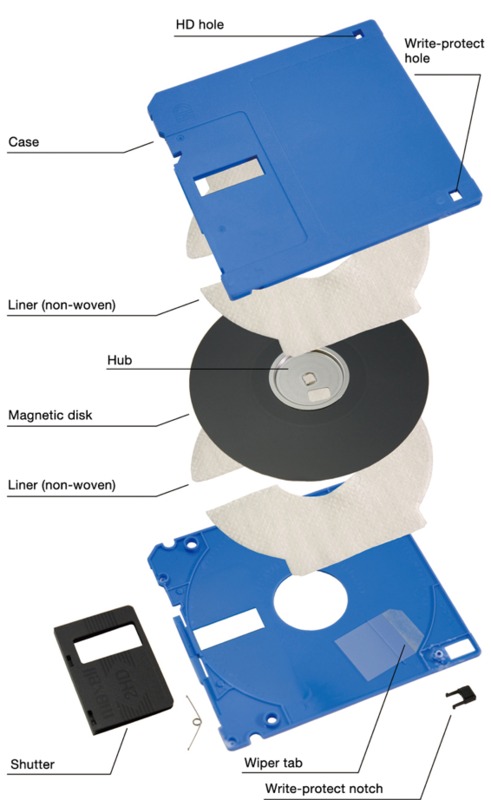About 3.5-Inch Floppy Disks
What is a floppy disk?
As cited in Disha Experts, a floppy disk is “a type of disk storage composed of a disk of thin and flexible magnetic storage medium, sealed in a rectangular plastic enclosure lined with fabric that removes dust particles" (Disha Experts, 2019). Its name comes from the 5.25-inch floppy disk, which was dubbed “floppy” because of its disk packaging of a very flexible envelope. Even though the 3.5-inch diskette was held by a rigid case, the name continued to prevail (Brown, 2001).
There are two main threats to an archivist's ability to preserve floppy disks: physical damage and degradation of the physical media, and the obsolescence of hardware and software necessary to read the disks.
Physical damage and degradation
Floppy disks need to be kept in good physical condition to be read. As with any physical media, the way that floppy disks are stored and handled can have a significant impact on their condition:
- High levels of heat or humidity. Humidity can cause the binder glue that holds the magnetic particles on a disk to either become soft and sticky, or brittle. If left in direct sun, high heat may physically warp or shrink the media making it impossible to read (Andolsen, 2006; Gough, 2013; LeFurgy, 2012; National Archives of Australia (NAA), n.d.).
- Dust or debris. Over time, it may adhere to the surface of the disk causing read errors (Gough, 2013). Likewise, touching the surface of the disk can leave damaging fingerprints (Ahl, 1983; Dicks & Iraci, 2017; NAA, n.d.).
- Storage. Storing disks on top of each other, jamming into boxes, or placing heavy objects on top of them can cause warping in the jackets making the disk spin unevenly (Ahl, 1983; NAA, n.d.).
- Bit rot. Over time, “the magnetic media slowly demagnetizes itself due to stresses like thermal cycling, and alternating magnetic fields nearby or even adjacent disks and movement of those disks” (Gough, 2013). As bits lose their magnetic orientation, data on the disk becomes corrupt (Salter, 2014; Wikipedia Contributors, 2019). The demagnetization can also occur instantaneously as a result of exposure to a magnetic field (Andolsen, 2006; Ahl, 1983; NAA, n.d.).
Hardware and software obsolescence
Given the complications associated with using legacy hardware and software, not to mention their scarcity, archivisits must find modern tools to read floppy disks. The hardware and software needed to read and image the disks depends on the format of the media:
- Hardware obsolescence. Due to different mechanical features of floppy disks, the quality of image capture can vary from different disk drives. For this reason, it can help to have multiple older disk drive on hand as certain drives are better equipped with reading particular disk formats (Durno, 2016; Waugh, 2014).
- Software obsolescence. Certain disk formats are not readable by standard USB disk drives, such as Mac-formatted disks, Microsoft’s DMF format with varying sector lengths, and copy protected disks (Durno, 2016; Gough, 2013; Waugh, 2014). Using the KryoFlux has been a successful work around for such disks, as well as for reading “flippy disks” (single-sided floppies with data written on both sides) in combination with a modified drive (Durno, 2016; Gough, 2013; Waugh, 2014; Archive Team, 2018).
What is a disk image?
Given the vulnerability of floppy disks to physical degradation and obsolescence over time, transferring data off of floppy disks is key for their preservation. To do so, best practice is to create a disk image.
Creating a disk image is a practice that the archives community has learned from the digital forensics community (Durno, 2016; Lee et al., 2013; Meister &Chassanoff, 2014). A disk image is a sector by sector copy of the entire disk, including the parts of the disk not usually seen by the user. A disk image captures "existing files and file structures as well as deleted files and unallocated disk space" (Gialanella, 2018). The disk image serves a baseline copy of the artifact. Any extraction of files or manipulation of the disk contents are done on the copy (Durno, 2016, Lee et al., 2013).
A disk image can be created using BitCurator. It is one of the best-known tools for digitization and preservation of electronic media, including 3.5-inch floppy disks. Since its conception in 2016, this free, open source software has quickly become the tool of choice for digital preservation, as it was developed specifically for the LAM community.
The following workflow section will walk you through our experience using BitCurator to digitize floppy disks for long term preservation.

